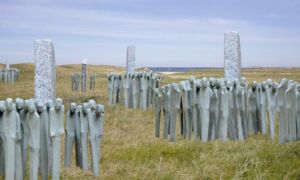Opinion
‘Mere te’ Vicar?: Remembrance and reconciliation
Darren McCallig
This article is more than 9 years old.

The memorial park is a stunning reminder of the human loss endured in the battle
On Wednesday 1 June, I attended a memorable and moving ceremony at Thyborøn on the west coast of Jutland. The occasion was the official opening of the Memorial Park at the Sea War Museum, planned to coincide with the centenary of the Battle of Jutland, the most devastating and destructive naval battle of the First World War.
Sinking into the sand
In that engagement between the Royal Navy’s Grand Fleet and the German High Seas Fleet, some 8,647 sailors died – most of them young men, and most of them killed where they worked, trapped below deck and unable to escape. The loss of life in those 24 hours is difficult to comprehend, but the Memorial Park that opened last week captures something of the scale of the devastation.
The park consists of 26 large granite stones, some of which are up to three and a half metres high. There is one for each of the 25 warships that sank, while the final one represents the vessels that were damaged but returned to port. The stones themselves jut out of the sand dunes in which they are placed, calling to mind the sterns of the enormous ships as they sank forever beneath the waves.
Poignant and unique
Around each stone is placed a number of tall, thin white figures, each one representing a sailor who died on that particular ship. The hope is that, eventually, there will be 8,647 of these sculptures – each one a standing memorial to a fallen seaman. The artist, Paul Cederdorff, explained that while the figures have a recognisable human form, they also give a ghost-like impression of a human blurred by the passage of time – a call, in other words, for us not to forget.
The other striking thing about the park is that it is, I’m told, the only official war memorial that commemorates the dead on both sides. The thousands of white sculptures wear no uniform and carry no flag. They are remembered, simply, as fellow human beings and bearers of our common humanity.
Former foes firm friends
That underlying unity, and hope of reconciliation, was much in evidence at the opening ceremony. The most poignant moment in the day’s proceedings was when direct descendants of the opposing naval commanders laid wreaths together.
Nick Jellicoe, a grandson of the British Admiral Sir John Jellicoe, and Reinhard Scheer-Henning, a great-grandson of the German Admiral Reinhard Scheer, spoke of how their forebears had planned to meet in the late 1920s, but Scheer’s death in 1928 had intervened. It was fitting, therefore, that 100 years to the day since the end of the Battle of Jutland, these two descendants came together to honour the fallen on all sides, shake hands and embrace.
The Memorial Park is a place not only of remembrance but also of reconciliation. It is a powerful reminder of the wars that have torn Europe apart in the past and a testament to how former foes can become allies and partners. As Anke Meyer, the German Embassy’s chargé d’affaires said in her speech at the opening, the greatest honour we can do those who lost their lives in war is to strive together for peace.

About
Darren McCallig
As the Irish-born vicar of Saint Alban’s Anglican Church, Darren has a congregation of over two dozen different nationalities (st-albans.dk). Celebrating diversity and building inclusive community are his divine aspirations. And yes – he enjoys a nice cup of tea.










































